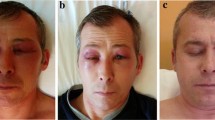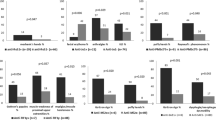Abstract
Autoantibodies are important in the diagnosis of dermatomyositis. They can be divided in two different groups: myositis-associated autoantibodies (MAA) prevailing in overlap syndromes, and myositis-specific autoantibodies (MSA), with diagnostic specificity exceeding 90%. Our purpose was to detect retrospectively the prevalence of the most common MSAs in a group of 19 adult DM patients (13 women, 6 men). A severe DM (SDM), with extensive cutaneous and muscular manifestations, dysphagia, and sometimes pneumopathy, was detected in ten cases. Three patients had a mild DM (MDM), with little muscle and skin impairment, and a short course. Four patients suffered from amyopathic DM (ADM), two from paraneoplastic DM (PDM). Each serum was tested for ANA, ENA, MAAs, MSAs. Myositis-specific autoantibodies were detected in 15 cases. The most frequent was anti-TIF1γ, associated with SDM or PDM in four out of seven cases. Anti-MDA5 antibodies were recorded in a SDM and in a ADM with lung fibrosis. Anti-Mi2 and anti-SRP antibodies were both detected in a MDM and in a SDM, whereas anti-SAE1 in a amyopathic form. Other antibodies (anti-NXP2, -Jo1, -PL7, -PL12, -OJ) were found in single patients with SDM. Our series confirmed that specific autoantibodies could be helpful to classify different clinical subsets, particularly in the case of paraneoplastic forms or association with pneumopathy. Moreover, they can help in predicting the disease evolution and influence therapeutic strategies. A greater number of cases should be useful to highlight the clinical and pathogenic role of these antibodies, and develop a homogeneous protocol for diagnosis and treatment.
Similar content being viewed by others
References
Allenbach Y, Benveniste O (2014) Autoantibody profile in myositis. Rev Med Interne 35:437–443
Andersen P (1977) Correlation of smooth-muscle and nuclear antibodies in normal subjects. Clin Exp Immunol 27:74–77
Anyanwu CO, Fiorentino D, Chung L, Dzuong C, Wang Y, Okawa J et al (2015) Validation of the cutaneous dermatomyositis disease area and severity index (CDASI): characterizing disease severity and assessing responsiveness to clinical change. Br J Dermatol 173:969–974
Benveniste O, Drouot L, Jouen F, Charuel JL, Bloch-Queyrat C, Behin A et al (2011) Correlation of anti-signal recognition particle autoantibody levels with creatine kinase activity in patients with necrotizing myopathy. Arthritis Rheum 63:1961–1971
Betteridge Z, Gunawardena H, North J, Slinn J, McHugh N (2007) Identification of a novel autoantibody directed against small ubiquitin-like modifier activating enzyme in dermatomyositis. Arthritis Rheum 56:3132–3137
Betteridge Z, McHugh N (2016) Myositis-specific autoantibodies: an important tool to support diagnosis of myositis. J Intern Med 280:8–23
Betteridge ZE, Gunawardena H, Chinoy H, North J, Ollier WE, Cooper RG et al (2009) Clinical and human leucocyte antigen class II haplotype associations of autoantibodies to small ubiquitin-like modifier enzyme, a dermatomyositis-specific autoantigen target, in UK Caucasian adult-onset myositis. Ann Rheum Dis 68:1621–1625
Bodoki L, Nagy-Vincze M, Griger Z, Betteridge Z, Szöllősi L, Dankó K (2014) Four dermatomyositis-specific autoantibodies-anti-TIF1γ, anti-NXP2, anti-SAE and anti-MDA5-in adult and juvenile patients with idiopathic inflammatory myopathies in a Hungarian cohort. Autoimmun Rev 13:1211–1219
Bohan A, Peter JB (1975) Polymyositis and dermatomyositis (first of two parts). N Engl J Med 292:344–347
Bohan A, Peter JB (1975) Polymyositis and dermatomyositis (second of two parts). N Engl J Med 292:403–407
Briani C, Doria A, Sarzi-Puttini P, Dalakas MC (2006) Update on idiopathic inflammatory myopathies. Autoimmunity 39:161–170
Brouwer R, Hengstman GJ, Vree Egberts W, Ehrfeld H, Bozic B, Ghirardello A et al (2001) Autoantibody profiles in the sera of European patients with myositis. Ann Rheum Dis 60:116–123
Callander J, Robson Y, Ingram J, Piguet V (2016) Treatment of clinically amyopathic dermatomyositis in adults: a systematic review. Br J Dermatol. doi:10.1111/bjd.14726
Cao H, Pan M, Kang Y, Xia Q, Li X, Zhao X et al (2012) Clinical manifestations of dermatomyositis and clinically amyopathic dermatomyositis patients with positive expression of anti-melanoma differentiation-associated gene 5 antibody. Arthritis Care Res (Hoboken) 64:1602–1610
Ceribelli A, Fredi M, Taraborelli M, Cavazzana I, Franceschini F, Quinzanini M et al (2012) Anti-MJ/NXP-2 autoantibody specificity in a cohort of adult Italian patients with polymyositis/dermatomyositis. Arthritis Res Ther 14:R97
Chaisson NF, Paik J, Orbai AM, Casciola-Rosen L, Fiorentino D, Danoff S et al (2012) A novel dermato-pulmonary syndrome associated with MDA-5 antibodies: report of 2 cases and review of the literature. Medicine (Baltimore) 91:220–228
Chinoy H, Fertig N, Oddis CV, Ollier WE, Cooper RG (2007) The diagnostic utility of myositis autoantibody testing for predicting the risk of cancer-associated myositis. Ann Rheum Dis 66:1345–1349
Christopher-Stine L, Casciola-Rosen LA, Hong G, Chung T, Corse AM, Mammen AL (2010) A novel autoantibody recognizing 200- and 100-kd proteins is associated with an immune-mediated necrotizing myopathy. Arthritis Rheum 62:2757–2766
Dalakas MC, Hohlfeld R (2003) Polymyositis and dermatomyositis. Lancet 2003(362):971–982
Espada G, Maldonado Cocco JA, Fertig N, Oddis CV (2009) Clinical and serologic characterization of an Argentine pediatric myositis cohort: identification of a novel autoantibody (anti-MJ) to a 142-kDa protein. J Rheumatol 36:2547–2551
Fiorentino D, Chung L, Zwerner J, Rosen A, Casciola-Rosen L (2011) The mucocutaneous and systemic phenotype of dermatomyositis patients with antibodies to MDA5 (CADM-140): a retrospective study. J Am Acad Dermatol 65:25–34
Fiorentino DF, Chung LS, Christopher-Stine L, Zaba L, Li S, Mammen AL et al (2013) Most patients with cancer-associated dermatomyositis have antibodies to nuclear matrix protein NXP-2 or transcription intermediary factor 1γ. Arthritis Rheum 65:2954–2962
Fiorentino DF, Kuo K, Chung L, Zaba L, Li S, Casciola-Rosen L (2015) Distinctive cutaneous and systemic features associated with antitranscriptional intermediary factor-1γ antibodies in adults with dermatomyositis. J Am Acad Dermatol 72:449–455
Fujimoto M, Hamaguchi Y, Kaji K, Matsushita T, Ichimura Y, Kodera M et al (2012) Myositis-specific anti-155/140 autoantibodies target transcription intermediary factor 1 family proteins. Arthritis Rheum 64:513–522
Fujimoto M, Matsushita T, Hamaguchi Y, Kaji K, Asano Y, Ogawa F et al (2013) Autoantibodies to small ubiquitin-like modifier activating enzymes in Japanese patients with dermatomyositis: comparison with a UK Caucasian cohort. Ann Rheum Dis 72:151–153
Ghirardello A, Bassi N, Palma L, Borella E, Domeneghetti M, Punzi L et al (2013) Autoantibodies in polymyositis and dermatomyositis. Curr Rheumatol Rep 15:335
Ghirardello A, Borella E, Beggio M, Franceschini F, Fredi M, Doria A (2014) Myositis autoantibodies and clinical phenotypes. Auto Immun Highlights 5:69–75
Ghirardello A, Zampieri S, Iaccarino L, Tarricone E, Bendo R, Gambari PF et al (2005) Anti-Mi-2 antibodies. Autoimmunity 38:79–83
Gunawardena H, Betteridge ZE, McHugh NJ (2009) Myositis-specific autoantibodies: their clinical and pathogenic significance in disease expression. Rheumatology (Oxford) 48:607–612
Hamaguchi Y, Kuwana M, Hoshino K, Hasegawa M, Kaji K, Matsushita T et al (2011) Clinical correlations with dermatomyositis-specific autoantibodies in adult Japanese patients with dermatomyositis: a multicenter cross-sectional study. Arch Dermatol 1(47):391–398
Hengstman GJ, ter Laak HJ, Vree Egberts WT, Lundberg IE, Moutsopoulos HM, Vencovsky J et al (2006) Anti-signal recognition particle autoantibodies: marker of a necrotising myopathy. Ann Rheum Dis 65:1635–1638
Iaccarino L, Ghirardello A, Bettio S, Zen M, Gatto M, Punzi L et al (2014) The clinical features, diagnosis and classification of dermatomyositis. J Autoimmun 48–49:122–127
Kalus A (2015) Rheumatologic skin disease. Med Clin N Am 99:1287–1303
Komura K, Fujimoto M, Matsushita T, Kaji K, Kondo M, Hirano T et al (2005) Prevalence and clinical characteristics of anti-Mi-2 antibodies in Japanese patients with dermatomyositis. J Dermatol Sci 40:215–217
Lazarou IN, Guerne PA (2013) Classification, diagnosis, and management of idiopathic inflammatory myopathies. J Rheumatol 40:550–564
Lega JC, Fabien N, Reynaud Q, Durieu I, Durupt S, Dutertre M et al (2014) The clinical phenotype associated with myositis-specific and associated autoantibodies: a meta-analysis revisiting the so-called antisynthetase syndrome. Autoimmun Rev 13:883–891
Love LA, Leff RL, Fraser DD, Targoff IN, Dalakas M, Plotz PH et al (1991) A new approach to the classification of idiopathic inflammatory myopathy: myositis-specific autoantibodies define useful homogeneous patient groups. Medicine (Baltimore) 70:360–374
Luo YB, Mastaglia FL (2015) Dermatomyositis, polymyositis and immune-mediated necrotising myopathies. Biochim Biophys Acta 1852:622–632
Mammen AL (2011) Autoimmune myopathies: autoantibodies, phenotypes and pathogenesis. Nat Rev Neurol 7:343–354
Marie I (2012) Morbidity and mortality in adult polymyositis and dermatomyositis. Curr Rheumatol Rep 14:275–285
Mastaglia FL, Phillips BA (2002) Idiopathic inflammatory myopathies: epidemiology, classification, and diagnostic criteria. Rheum Dis Clin N Am 28:723–741
Mimori T, Nakashima R, Hosono Y (2012) Interstitial lung disease in myositis: clinical subsets, biomarkers, and treatment. Curr Rheumatol Rep 14:264–274
Moghadam-Kia S, Aggarwal R, Oddis CV (2015) Treatment of inflammatory myopathy: emerging therapies and therapeutic targets. Expert Rev Clin Immunol 11:1265–1275
Muro Y, Sugiura K, Akiyama M (2013) Low prevalence of anti-small ubiquitin-like modifier activating enzyme antibodies in dermatomyositis patients. Autoimmunity 46:279–284
Muro Y, Sugiura K, Hoshino K, Akiyama M, Tamakoshi K (2011) Epidemiologic study of clinically amyopathic dermatomyositis and anti-melanoma differentiation-associated gene 5 antibodies in central Japan. Arthritis Res Ther 13:R214
Oddis CV, Conte CG, Steen VD, Medsger TA Jr (1990) Incidence of polymyositis-dermatomyositis: a 20-year study of hospital diagnosed cases in Allegheny County, PA 1963–1982. J Rheumatol 17:1329–1334
Rutjes SA, Vree Egberts WT, Jongen P, Van Den Hoogen F, Pruijn GJ, Van Venrooij WJ (1997) Anti-Ro52 antibodies frequently co-occur with anti-Jo-1 antibodies in sera from patients with idiopathic inflammatory myopathy. Clin Exp Immunol 109:32–40
Sato S, Hirakata M, Kuwana M, Suwa A, Inada S, Mimori T et al (2005) Autoantibodies to a 140-kd polypeptide, CADM-140, in Japanese patients with clinically amyopathicdermatomyositis. Arthritis Rheum 52:1571–1576
Smoyer-Tomic KE, Amato AA, Fernandes AW (2012) Incidence and prevalence of idiopathic inflammatory myopathies among commercially insured, Medicare supplemental insured, and Medicaid enrolled populations: an administrative claims analysis. BMC Musculoskelet Disord 13:103
Tansley SL, Betteridge ZE, McHugh NJ (2013) The diagnostic utility of autoantibodies in adult and juvenile myositis. Curr Opin Rheumatol 25:772–777
Targoff IN, Johnson AE, Miller FW (1990) Antibody to signal recognition particle in polymyositis. Arthritis Rheum 33:1361–1370
Targoff IN, Mamyrova G, Trieu EP, Perurena O, Koneru B, O’Hanlon TP et al (2006) A novel autoantibody to a 155-kd protein is associated with dermatomyositis. Arthritis Rheum 54:3682–3689
Targoff IN, Reichlin M (1985) The association between Mi-2 antibodies and dermatomyositis. Arthritis Rheum 28:796–803
Targoff IN (1992) Autoantibodies in polymyositis. Rheum Dis Clin N Am 18:455–482
Venables PJ (1997) Antibodies to Jo-1 and Ro-52: why do they go together? Clin Exp Immunol 109:403–405
Walter P, Blobel G (1982) Signal recognition particle contains a 7S RNA essential for protein translocation across the endoplasmic reticulum. Nature 299:691–698
Whelan BR, Isenberg DA (2009) Poor response of anti-SRP-positive idiopathic immune myositis to B-cell depletion. Rheumatology (Oxford) 48:594–595
Author information
Authors and Affiliations
Corresponding author
Ethics declarations
Funding
This research did not receive any specific grant from funding agencies in the public, commercial, or not-for-profit sectors.
Conflict of interest
The authors declare that they have no conflict of interest.
Additional information
G. Merlo and A. Clapasson contributed equally to this manuscript, respectively, for the medical and laboratory section.
Rights and permissions
About this article
Cite this article
Merlo, G., Clapasson, A., Cozzani, E. et al. Specific autoantibodies in dermatomyositis: a helpful tool to classify different clinical subsets. Arch Dermatol Res 309, 87–95 (2017). https://doi.org/10.1007/s00403-016-1704-1
Received:
Revised:
Accepted:
Published:
Issue Date:
DOI: https://doi.org/10.1007/s00403-016-1704-1




